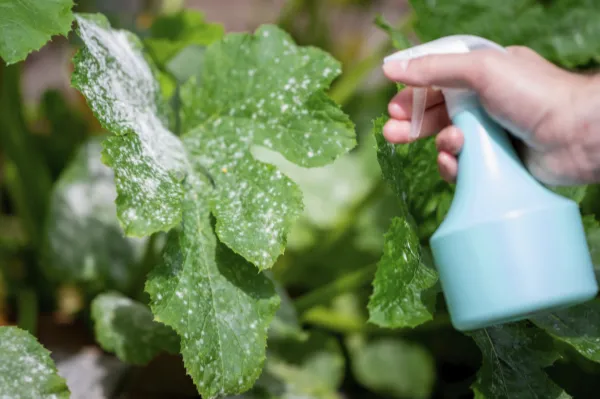
Tips to Identify and Treat Powdery Mildew in Your Vegetable Gardens
As I was harvesting my strawberries this week, I started to see early signs of powdery mildew. As a seasoned gardener, it is not uncommon to experience fungal diseases in your vegetable garden. Understanding what to look for and addressing it quickly will prevent it from spreading to other plants.
This post will teach you how to identify powdery mildew, provide tips for treating it, and offer ways to help prevent its occurrence.
How to identify powdery mildew in your vegetable garden
The first signs of powdery mildew show up on the leaves of your plant in the form of grayish or whitish powdery-looking substance. Once it affects the leaves, it can start to spread to the fruit on your plants. If left untreated, the leaves of your plants will begin to yellow and eventually start to die.
Fruiting plants are susceptible to powdery mildew, affecting both plants and trees. Vegetable plants, such as cucumbers and squash, are sensitive to powdery mildew, while strawberries, melons, apples, and grapes are also susceptible to this disease.

What causes powdery mildew
Powdery mildew is caused by warm conditions, accompanied by high humidity at night. In the case of my strawberries, we experienced some rainfall followed by warm temperatures, creating perfect conditions for powdery mildew to form.
Spread through spores, a simple breeze or an insect can easily transfer spores from one vegetable to another. Another common way is through your gardening pruners. That is why it is important to sanitize your gardening pruners between plants, preventing the spread of powdery mildew spores.
Ways to treat vegetable plants that have powdery mildew
What I have found to be most effective in treating powdery mildew is a fungicide. Popular treatments include copper, neem oil, and baking soda for powdery mildew. Each option works well, but if overused, they can harm your plants.
In my garden, I keep a copper-based fungal treatment from Bonide in my arsenal. Copper treatment is a versatile and effective method for killing both fungal and bacterial diseases. I typically keep this on hand for treating my roses and other perennials, but I do use it occasionally for my kitchen garden, as I find it very effective. The downside is that it’s not organic, young foliage can be sensitive to copper. When used too frequently, it can accumulate on your soil surface and disrupt standard growth patterns. (Please Note: As an Amazon Associate, I earn a small commission from qualifying purchases)
Neem oil is another effective treatment for powdery mildew, as well as a preventive measure against unwanted garden pests. Although Organic, if used frequently, the oil can block the plant's spores, preventing them from absorbing sunlight and reducing photosynthesis. I recommend only using Neem oil sparingly because it can accumulate on the leaves if applied regularly.

A popular organic and DIY method for powdery mildew consists of mixing one tablespoon of baking soda, one teaspoon of Castile soap, and a gallon of water. Spray the mixture on both sides of the infected leaves. Using too much of this application can lead to leaf burn.
When treating any fungal disease, it is best to apply treatment to plants once a week, as soon as visible signs of a fungal problem appear. If you experience heavy rain after treating your plants, it is best to reapply the treatment after waiting a few days. To prevent over-treatment, reapply the fungicide only if the powdery mildew persists. Typically, one to two treatments are sufficient to resolve the issue.
Tips for preventing powdery mildew before it starts
Tip 1: Prune your plants for increased airflow. To increase air circulation, pruning and removing the lower leaves and stems can help improve airflow, which in turn helps prevent powdery mildew. This is an especially effective method for squash. As the squash plants grow, they produce new leaves, and the existing leaves tend to grow quite large, blocking airflow. Removing all yellow leaves and stems is just as essential to help prevent the spread of spores to healthy branches, and is considered a best gardening best practice.
Tip 2: Plant rotation. When you've been gardening for a few seasons, it's easy to stick to what has worked in the past. But disease and pest prevention are why we recommend changing your garden layout. Rotating the placement of items in your garden can help prevent the development of powdery mildew on your fruiting plants. By replacing the host plant with a less susceptible plant family, such as carrots or legumes, you can prevent the powdery mildew from recurring in the same spot.
Tip 3: Water at the base of the plant. Powdery mildew typically forms during warm daytime, high moisture levels, and cool overnight temperatures. When watering your plants, avoid splashing water on the leaves. Watering at the base of the plant helps prevent the start of powdery mildew on the leaves where it is most susceptible to the disease.
Don't let powdery mildew get you down!
Now that you have an understanding of how to identify it, treatments for it, and preventive measures like pruning for airflow and careful watering, you can keep your vegetable garden healthy and thriving. Remember, a little vigilance goes a long way.
For more information about Garden to Table Consulting, including gardening tips, visit our website and follow our blog, Your Path To The Plate.
